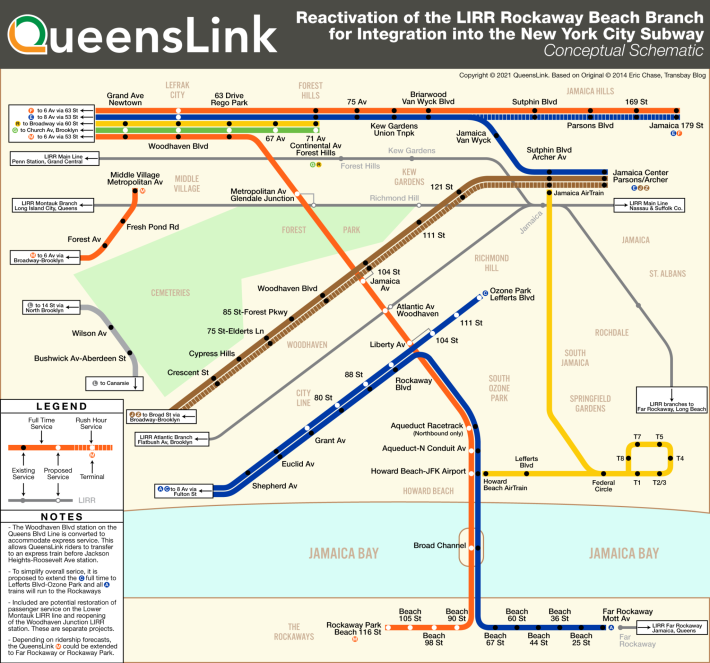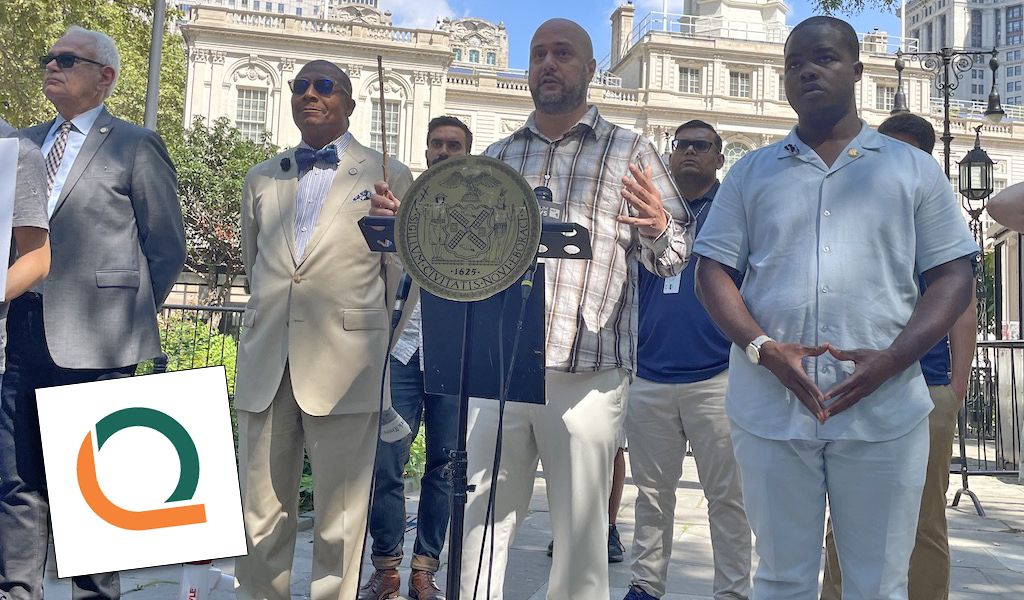Transit makes strange bedfellows.
Elected officials across the political spectrum rallied with transit advocates on Wednesday to urge the MTA and the city to build the QueensLink, reactivating an old transit route between southeast and central Queens.
The rally was the latest push to move the central Queens subway expansion from theory to reality, with elected officials representing the spectrum of local Democratic politics, from DSA Assembly Member Zohran Mamdani to the Common Sense Caucus City Council Member Bob Holden, showing up to demand a project that supporters say can add both new train service and acres of park land to Queens.
"To my friend, Mr. Mayor, this is our time," said state Sen. James Sanders, who represents Far Rockaway. "Yes, we want a park and yes we want a light rail. We can have both. New York is not a place where you choose. We come here because in New York, you want it all."
Sanders's comments got at the central tension of the QueensLink proposal, which is that its supporters aren't the only people with their eye on the abandoned rail right of way. A competing group of Queens residents has been pushing the QueensWay, a High Line-style park for the overgrown tracks. That idea got a boost last year when Mayor Adams announced $35 million in funding for the design of the first phase of the QueensWay.
QueensLink supporters have countered that their plan manages to use the right of way for its original purpose — mass rapid transit — and also provides 33 acres of park space and bike paths, giving Queens residents the best of both worlds.
Since last year's QueensWay announcement, the project has advanced; an engineering firm was given a contract for design of the educational and recreational known as the Metropolitan Hub, plus an environmental review to be completed in 2024. The mayor's office said none of that work precludes a transit option if that's what the MTA wants to do, however.
"Mayor Adams last fall announced a $35 million in new open space for Queens residents, and the administration is moving that work forward with community engagement underway and a design consultant on board," said mayoral spokesman Charles Lutvak. "As we’ve always said, the proposed Met Hub does not preclude an MTA project if they determine one is feasible, and we are ready to partner with them if they decide to move forward."
That one year anniversary of the QueensWay announcement was on the minds of QueensLink boosters who came out on Wednesday.
"It's important that we keep the public pressure on," said Mike Scala, the counsel and legal adviser for the QueensLink. "We just want to make sure that the public is educated on the issue and can speak on it. And from what we've found, we've done a lot of canvassing in the neighborhoods, people want both; they don't tell you, 'We want just a park and no train.'"
If the project got off the ground, supports say the QueensLink could connect Rockaway to Middle Village and even allow the MTA to simplify its existing service to the beach peninsula by running A trains to Far Rockaway and the new service to Beach 116th Street.

The idea relies on reviving a 3.5-mile stretch of abandoned rail tracks and right of way that runs from Ozone Park to Rego Park and was once part of the Long Island Rail Road's Far Rockaway branch. However, there are multiple issues in the way.
Beyond the fact that the QueensWay plan seems to have the upper hand at the moment, there's also the huge question as to whether the MTA itself wants to build the QueenLink anyway.
The agency has not jumped at the chance to do the project so far. It studied how much it would cost to restore service to the right of way in 2017 and then buried the report, which was only released because of public. pressure. But once the report came out, it pegged the cost at $8.1 billion, which QueensLink supporters said was purposefully inflated to kill it. Those supporters later came out with their own cost estimate, saying it would cost between $3.4 billion and $3.7 billion.
The MTA has resisted calls to do an environmental impact statement on the QueensLink, though agency spokespeople and leadership have said that doesn't mean that the MTA has completely closed the coffin on the project.
The agency's term for the project, the Rockaway Beach Branch reactivation, is among the expansion projects listed for study and potential inclusion in the MTA's upcoming 20-Year Needs Assessment, a document that guides the agency's maintenance and expansion strategies for its capital plans. MTA five-year capital plans focus almost entirely on state of good repair work for the system, but a number of expansion projects get kicked around for inclusion in the needs assessment.
"A full-blown EIS at this point would not be warranted as we are engaged right now in our 20-year needs assessment process," MTA Deputy Chief for Government and Community Relations Will Schwartz told the City Council in August. "The QueensLink ... is part of this comparative evaluation that we’re moving forward with now."
It's not entirely out of pocket to suggest the MTA reactivate old infrastructure or build on what already exists to expand the system, in light of recent projects the MTA has undertaken. In a similar vein to the QueensLink proposal, the MTA is currently doing environmental review in preparation for building the Interborough Express, a light rail project connecting Brooklyn and Queens that will be built in an existing right of way that is currently used only for freight rail.
And in the east Bronx, the agency is connecting commuter rail and the Boogie Down to Penn Station by building four new Metro-North stations in neighborhoods where trains currently pass through without stopping, a project known as Penn Access.
The needs assessment is supposed to come out in early October, and while Scala said he has some confidence the project could make it into the planning document.
"We've been locked out of the conversation before. It wouldn't be the first time, but we are confident though, that we will be included now. Especially with all the support that we've garnered," he said.






